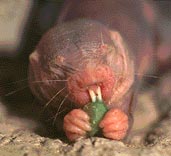Research index
Miller Lab home page
The overall goal of this set of projects is to develop a gene expression "signature" of decelerated aging in mice. The models under investigation include (a) calorically restricted (CR) mice; (b) methionine restricted mice; (c) Snell dwarf mice; and (d) wild-derived mouse stocks. Each of these models is described in more detail elsewhere on this web site. The strategy is to compile a listing of genes altered by each of these genetic or dietary manipulations, and then to inspect these lists for overlap to compile a common set of genes whose expression patterns are characteristic of longer lived mouse populations. The goal of this study is not to examine to what extent age effects are retarded in the various models, but instead to determine what gene changes, early in life, are most likely to contribute to extended longevity.
The initial work has been conducted using nylon membrane arrays provided by Clontech. An analysis of liver gene expression in young adult Snell dwarf mice (compared to nonmutant littermate controls) has produced a listing of 60 genes, among 2352 examined, for which the difference between mutant and control mice reaches statistical significance at the p < 0.001 level. A slightly less restrictive criterion, based on the "SAM" algorithm of Tusher et al., yields a list of 72 genes for which the false discovery rate is below 5%. A list of these genes can be obtained by sending an e-mail request to millerr@umich.edu.
The second stage of the analysis, conducted in collaboration with Andrzej Bartke and John Kopchick, is comparing CR mice to mice fed ad libitum. An initial analysis has produced a listing of well over 100 genes that are over- or under-expressed in the CR mice, among which about a dozen are also altered by the dw/dw mutation. This study is now being prepared for publication.
2. Comparisons of statistical methods for gene selection.
We have published several papers showing the advantages of applying formal statistical methods for the discovery of genes altered by experimental conditions (age, diet, mutation), and showing the high error rates that emerge from studies in which gene selection is based on crude ratio statistics alone. Click here for a figure comparing the effectiveness of statistical methods to ratio-based criteria for reducing the error rates in gene expression studies. Click here for a figure showing the effect of sample size (number of independent mice in each study group) on the number of significant genes that can be detected in a study of differences between dwarf and normal mice.
3. Work in progress.
Several new studies are just now getting under way. These include:
- A study of differences in gene expression patterns between short-lived rodents (mice) and very long-lived rodents (naked mole rats). Collaborator: Tim O'Connor
- A study of the effects of aging and psychological stress on gene expression in human T lymphocytes. Collaborators: James House, George Kaplan, Jeffrey Halter
Support: these gene expression studies are supported largely by the Gene Expression Profiling Core of the Nathan Shock Center (NIA grant AG13283). Start-up support has also been provided by a pilot grant from the University of Michigan Bio-informatics program and by an equipment grant from the University's Biomedical Research Council.
Clontech Array
Microarray
Comparing ratio and statistical criteria for gene selection

A
naked mole rat:
25 grams, lives 25 years